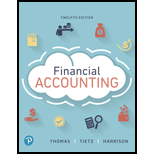
Financial Accounting (12th Edition) (What's New in Accounting)
12th Edition
ISBN: 9780134725987
Author: C. William Thomas, Wendy M. Tietz, Walter T. Harrison Jr.
Publisher: PEARSON
expand_more
expand_more
format_list_bulleted
Concept explainers
Question
Chapter 9, Problem 9.1S
1.
To determine
To indicate: True or False
2.
To determine
To indicate: True or False
3.
To determine
To indicate: True or False
4.
To determine
To indicate: True or False
5.
To determine
To indicate: True or False
6.
To determine
To indicate: True or False
Expert Solution & Answer
Want to see the full answer?
Check out a sample textbook solution
Students have asked these similar questions
Financial accounting
Provide correct answer this accounting question
I am searching for the accurate solution to this financial accounting problem with the right approach.
Chapter 9 Solutions
Financial Accounting (12th Edition) (What's New in Accounting)
Ch. 9 - Brownlee Company issued 525,000, 8%, six-year...Ch. 9 - A bond with a face value of 250,000 and a quoted...Ch. 9 - Mission Furniture issued 500,000 in bonds payable...Ch. 9 - Bonds with an 8% stated interest rate were issued...Ch. 9 - Brimfest Corporation issued 2,400,000, 10-year, 6%...Ch. 9 - The Discount on Bonds Payable account a.is an...Ch. 9 - The discount on a bond payable becomes...Ch. 9 - The carrying value of Bonds Payable equals a.Bonds...Ch. 9 - Prob. 9QCCh. 9 - Prob. 10QC
Ch. 9 - Prob. 11QCCh. 9 - When a company retires bonds early, the gain or...Ch. 9 - Which type of lease will not increase a companys...Ch. 9 - Prob. 14QCCh. 9 - The debt ratio is calculated by dividing: a. total...Ch. 9 - Prob. 16QCCh. 9 - Prob. 17QCCh. 9 - Prob. 9.1ECCh. 9 - Prob. 9.1SCh. 9 - (Learning Objective 1: Determine bond prices at...Ch. 9 - (Learning Objective 1: Journalize basic bond...Ch. 9 - Prob. 9.4SCh. 9 - Prob. 9.5SCh. 9 - Prob. 9.6SCh. 9 - Prob. 9.7SCh. 9 - Prob. 9.8SCh. 9 - (Learning Objective 2: Account for bonds payable...Ch. 9 - Prob. 9.10SCh. 9 - LO 4,5 (Learning Objectives 4, 5: Deferred income...Ch. 9 - LO 5 (Learning Objective 5: Compute and evaluate...Ch. 9 - LO 5 (Learning Objective 5: Calculate the leverage...Ch. 9 - LO 6 (Learning Objective 6: Report liabilities)...Ch. 9 - (Learning Objective 1: Issue bonds payable...Ch. 9 - Prob. 9.16AECh. 9 - Prob. 9.17AECh. 9 - LO 2 (Learning Objective 2: Issue bonds payable...Ch. 9 - Prob. 9.19AECh. 9 - LO 4 (Learning Objective 4: Account for deferred...Ch. 9 - (Learning Objective 5: Evaluate debt-paying...Ch. 9 - LO 4, 5 (Learning Objectives 4, 5: Analyze current...Ch. 9 - Prob. 9.23AECh. 9 - (Learning Objective 1: Issue bonds payable...Ch. 9 - Prob. 9.25BECh. 9 - Prob. 9.26BECh. 9 - Prob. 9.27BECh. 9 - Prob. 9.28BECh. 9 - LO 4 (Learning Objective 4: Account for deferred...Ch. 9 - Prob. 9.30BECh. 9 - Prob. 9.31BECh. 9 - Prob. 9.32BECh. 9 - A bond with a face amount of 12,000 has a current...Ch. 9 - The carrying value on bonds equals Bends Payable...Ch. 9 - Prob. 9.35QCh. 9 - Prob. 9.36QCh. 9 - Prob. 9.37QCh. 9 - Prob. 9.38QCh. 9 - Prob. 9.39QCh. 9 - Prob. 9.40QCh. 9 - Prob. 9.41QCh. 9 - Prob. 9.42QCh. 9 - Prob. 9.43QCh. 9 - Prob. 9.44QCh. 9 - Prob. 9.45QCh. 9 - Prob. 9.46QCh. 9 - Prob. 9.47QCh. 9 - Prob. 9.48QCh. 9 - Prob. 9.49QCh. 9 - Prob. 9.50APCh. 9 - (Learning Objectives 1, 6: Issue bonds at a...Ch. 9 - Prob. 9.52APCh. 9 - Prob. 9.53APCh. 9 - (Learning Objectives 2, 3, 6: Issue convertible...Ch. 9 - Prob. 9.55APCh. 9 - Prob. 9.56BPCh. 9 - Prob. 9.57BPCh. 9 - Prob. 9.58BPCh. 9 - Prob. 9.59BPCh. 9 - (Learning Objectives 2, 3, 6: Issue convertible...Ch. 9 - (Learning Objectives 4, 5, 6: Report liabilities...Ch. 9 - Prob. 9.62CEPCh. 9 - Prob. 9.63CEPCh. 9 - Prob. 9.64SCCh. 9 - (Learning Objective 5: Explore an actual...Ch. 9 - Prob. 1FF
Knowledge Booster
Learn more about
Need a deep-dive on the concept behind this application? Look no further. Learn more about this topic, accounting and related others by exploring similar questions and additional content below.Similar questions
- Please provide the solution to this accounting question using proper accounting principles.arrow_forwardI need help with this financial accounting question using the proper accounting approach.arrow_forwardCan you explain this general accounting question using accurate calculation methods?arrow_forward
- Can you solve this financial accounting problem using appropriate financial principles?arrow_forwardPlease provide the answer to this accounting question with proper steps.arrow_forwardWhat amount of ending finished goods inventory will be reported on the balance sheet under variable costing ?arrow_forward
arrow_back_ios
SEE MORE QUESTIONS
arrow_forward_ios
Recommended textbooks for you
 Financial Accounting: The Impact on Decision Make...AccountingISBN:9781305654174Author:Gary A. Porter, Curtis L. NortonPublisher:Cengage Learning
Financial Accounting: The Impact on Decision Make...AccountingISBN:9781305654174Author:Gary A. Porter, Curtis L. NortonPublisher:Cengage Learning Excel Applications for Accounting PrinciplesAccountingISBN:9781111581565Author:Gaylord N. SmithPublisher:Cengage Learning
Excel Applications for Accounting PrinciplesAccountingISBN:9781111581565Author:Gaylord N. SmithPublisher:Cengage Learning

Financial Accounting: The Impact on Decision Make...
Accounting
ISBN:9781305654174
Author:Gary A. Porter, Curtis L. Norton
Publisher:Cengage Learning

Excel Applications for Accounting Principles
Accounting
ISBN:9781111581565
Author:Gaylord N. Smith
Publisher:Cengage Learning
Bond Valuation - A Quick Review; Author: Pat Obi;https://www.youtube.com/watch?v=xDWTPmqcWW4;License: Standard Youtube License